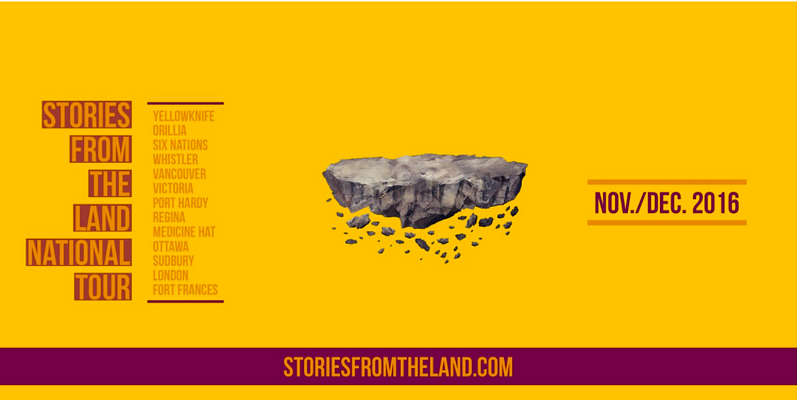
It started with a tweet. A simple linguistic shift put forward by Damien Lee (@damienlee). Moving from saying Canada or even “…in what is now Canada,” to, “…in what is currently Canada,” in order to “open possibilities for imagining futurities beyond the settler state.”
When I write, I avoid the phrase "…in what is now Canada." I use "…in what is currently Canada" to open possibilities for imagining futurities beyond the settler state.
— Damien 🦑 (@damienlee) January 31, 2018
I read the tweet right before teaching my Contemporary Indigenous Education course, and decided to model (and make explicit) my own language choices for my students. I used “in what is currently the United States/Canada/Mexico” throughout the class period, and told the class why. From that class on, as well as in their weekly discussion posts, my students have used the same phrasing. My course is made up predominantly of non-Natives, and there’s something so powerful for me in that small act. It gave me the power to imagine an otherwise.
Because, let’s be real. The world is a hot mess right now. Things are awful. I don’t need to do a rundown of how awful, you all live in the same world and consume the same daily barrage of news that I do. But it’s been hard to keep going, keep fighting, keep learning, and keep growing when the world seems to be crumbling around us.
So in the last few weeks, I’ve clung to this idea of being able to imagine something different, and I’ve turned to indigenous futurisms to get me through. What are indigenous futurisms? The term was first coined by Anishinaabe scholar Grace Dillon in the early 2000’s, who has continued to do amazing work in the field). Native author (and Nebula award nominated!) Rebecca Roanhorse defines the term for us in Uncanny Magazine:
Indigenous Futurisms is a term meant to encourage Native, First Nations, and other Indigenous authors and creators to speak back to the colonial tropes of science fiction—those that celebrate the rugged individual, the conquest of foreign worlds, the taming of the final frontier. Indigenous Futurism asks us to reject these colonial ideas and instead re-imagine space, both outer and inner, from another perspective. One that makes room for stories that celebrate relationship and connection to community, coexistence, and sharing of land and technology, the honoring of caretakers and protectors.
Indigenous Futurism also advocates for the sovereign. It dares to let Indigenous creators define themselves and their world not just as speaking back to colonialism, but as existing in their own right. That is not to say that the past is ignored, but rather that it is folded into the present, which is folded into the future—a philosophical wormhole that renders the very definitions of time and space fluid in the imagination.
These pieces of indigenous art, writing, film, whatever it may be posit a future where our indigenous ways of knowing, being, and relating allow us to re-imagine, re-create, and exist–while also looking to the past and the present simultaneously. Anishinaabe scholar, artist, and game designer Elizabeth LePensee told me that the most important aspect of Indigenous Futurisms which most people misunderstand is that, “it’s about past/present/future–the hyperpresent now. That we look seven generations before, and seven generations ahead.” While western science fiction tends to think solely the future, Indigenous futurisms, “reflects all spacetimelines and sees how they are all connected.” Exploring the hyperpresent now through these works has given me respite, validation, energy, and yes, hope.
I’m so tired. I’ve been fighting a million things behind the scenes and feeling stalled with my writing and work, and trying to figure out how to jump back into blogging when the last few months have been posts about heavy, hard, uncomfortable truths. I needed something to push me out of the dark and back into the writing that has brought me so much joy and power.
Enter Wakanda.
<I don’t think there are any real Black Panther spoilers here but I am going to talk about some minor plot points and the fact that Wakanda is a setting in the movie, so do with that what you will>
I went to see Black Panther by myself on Thursday after an especially long week, and as the lights came up I found myself sitting there in the theater with tears in my eyes. As I said on twitter, the idea of an indigenous place untouched by colonization was hella overwhelming and just beautiful.
I saw Black Panther tonight. I may or may not have started crying at several times when it was completely inappropriate because the idea of a truly decolonized indigenous place was just hella overwhelming.
— Dr. Adrienne Keene (@NativeApprops) February 23, 2018
In Wakanda, modernity, technology, and tradition live side by side. They’re not seen as antithetical, or put in opposition. As Native folks our indigenous knowledges have always been seen by colonizers as “folk knowledge” or standing in the way of progress and “true scientific” knowledge. That is, unless indigenous knowledges affirm western scientific “discoveries” (see this recent article by Smithsonian Magazine). So seeing, actually *seeing* on the massive IMAX screen a place that thrived and developed without western intervention, an indigenous nation that was allowed to keep and harness its incredibly valuable natural resources (in this case Vibranium) and wasn’t mined and exported to the West, where a young black woman is the scientific genius behind Wakanda’s technology, where a bustling outdoor market has levitating buses and woven baskets, and where ancestral tradition at Warrior Falls determines who gets to wear a superhero suit? Mind blowing.

We had Wakandas on Turtle Island prior to colonization. Recently one was “discovered” in what is currently Guatemala–more than 60,000 structures hidden to western scientists (but obviously known to indigenous folks) in the deep jungle for thousands of years. We had Cahokia. We had Teotihuacan. and on and on. But popular culture doesn’t allow us to see those cities, those places where indigenous knowledge and technologies allowed for sustainable, complex, and modern living. Instead, we see, over and over, the time period of the height of colonization. We get the Revenant, Hostiles, Dances with Wolves, The Lone Ranger. We get narratives of tipis on the Plains, one small historic sliver and window into our existence. So to be able to see the result of what one of those pre-contact cities and societies could have become without colonial interference is wild. Yes it’s a comic book movie. Yes it’s fantasy. But that imagination is powerful.

There are plenty of things that we could critique about Black Panther, but I don’t want to do that here. I just want to think about what it means to see and to imagine Wakanda.
(An important point to think through too, perhaps in another post, is that Wakanda means God/Creator for Osage, Otoe, and Ponca tribes. I don’t know enough about the Marvel universe to know the origin of the term in Black Panther context, but it’s an aside I’d be remiss to leave out.)
So for the next few posts, or for as long as I feel up to it, I’m going to be showcasing some cool work being done in Indigenous futurisms. A disclaimer, I’m new to this conversation. Definitely not claiming expertise, but just wanting to bring us all along together into a space (both figurative and maybe literally space as in the sky) where we can start to challenge the norms that place us as indigenous peoples in the past, as historic or extinct, and as antithetical to the future. I believe very strongly that indigenous knowledges can save the world. But it requires a dramatic reimagining, and the ability to dream. That’s what I want and need right now, and I know some of you probably do too.
So we push onward looking back into the future.

ETA 2/26: I just wanted to make clear what my approach was with this post–I just wanted to share how my own personal experience in viewing Black Panther connected with my own relatively recent dive into indigenous futurisms. I had also edited a paragraph above before posting that I realized took out my shout out to afrofuturism. I’m not attempting to argue here that Black Panther is an example of indigenous futurism, it is decidedly within the well established and long tradition of afrofuturism, and indigenous futurisms definitely acknowledge and build on that tradition as well. Nor am I attempting to conflate my own experience as a white coding indigenous person with the experiences of black folks (in diaspora or not). Our experiences with colonialism share many things, but also diverge dramatically, and those unique experiences are important. This was just supposed to be a “Hi I saw Black Panther and it made me cry and think these things” post, so I apologize if folks felt it ignored or erased or re-centered Turtle Island indigeneity in a way that was problematic or harmful. Obviously lots of bigger conversations to be had around the intersections and incommensurabilities of African, Black, and Indigenous experiences (and the way those three identities and positionalities are in no way mutually exclusive). As always, I’m consenting to learn in public, and as I said above, new to the Indigenous Futurisms convo, so I hope that folks will continue to join me on that journey. Thanks to the readers who reached out and asked me to clarify this.
Additional ETA: Here is my full apology.
(and thanks for all the support and love for the last few months as things have been quiet around here)















